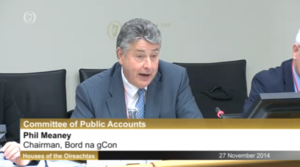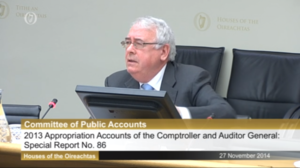

Labour TD, Joe Costelloe and Phil Meaney, chairman of the Irish Greyhound Board
Last month, the Comptroller and Auditor General produced a report on the Irish Greyhound Board’s development of Limerick Greyhound Stadium.
The report found the board bought a site for the new stadium in Meelick, on the Limerick/Clare border in April 2005 for €1.02million, while another €935,000 was spent on development, design and project planning on the site.
The C&AG found a consultant’s report – that was prepared before the site was bought – raised concerns about the site’s access to the national road network. The C&AG also found no record that this report was either presented or discussed by the board before they made the purchase.
The plans to build the stadium on the Meelick site were then abandoned because of access issues. The IGB still owns the site and it’s now valued at €150,000, according to the C&AG.
The IGB then bought another site in Greenpark, in June 2008, for €3.4million, or €304,900 per acre, without getting an up-to-date valuation report before the purchase. Additional costs arose because of issues in relation to the filling of the Greenpark site and the use of an adjoining car park.
The C&AG concluded:
“Bord na gCon incurred total expenditure of €21 million in relation to the Limerick stadium project. This contributed to a doubling of Bord na gCon’s borrowing, compared to the average borrowing level in 2006-2008.”
Further to this, Labour TD Joe Costelloe asked the board’s chairman, Phil Meaney, if anyone has been held accountable for the ill-conceived plans.
Joe Costelloe: “There was nobody in charge from a financial point of view.”
Phil Meaney: “Again, I’m not sure whether there was a financial CFO [Chief Financial Officer] in place at the time the decision was made. From memory there was, it was some time after that that we were without a finance director but I accept that every organisation should have a chief financial officer and, as I say, the current board moved quickly to fill that gap. The other point, deputy, I’d like to make is that, following on from what Geraldine [CEO of IGB Geraldine Larkin] has said, as regards, you know, the present board and the previous board, you know, we weren’t involved and I think that’s a point, in that actual decision. But we’re very happy and we recognise our responsibility in dealing with the consequences of that decision, both as a board and as an executive…”
Costelloe: “Ok, so moving on from where we are at the present time but we have to look back as that is what the analysis here, the auditor’s report has given us. And there seems to have been submissions made in relation to the purchase of the original site, the Meelick site, even though it would have been, it should have been obvious to anybody that this was not a satisfactory site. And, as a result, well the site was purchased for €1.75million – there has now been a write-off of €1.6million on side. What was the relationship between the executive and the board on that matter? How was the decision made to purchase a site that was unusable because there was a lack of access and it wasn’t a suitable site and nothing was ever built on it? How could such a big decision be made? And then find out, subsequently, that you could not proceed with it for the purpose intended for the new track, headquarters?”
Meaney: “Well, again, I would say, deputy, through the chair, that it’s 10 years ago now almost, a month short of 10 years since that decision to purchase Meelick was made. The only thing that I can say on it, from the paper trail that exists and from the findings of the C&AG, you know, I accept that it was, it doesn’t seem a good decision but again, it wasn’t a good decision, it was an atrocious decision.”
Costelloe: “I mean, any right-thinking person would not have made the decision where you would buy a site where there was identified, the whole issue of access was identified prior to the purchase of the site. The site was bought, then of course the issue of access, prevented the site from being developed but it was identified in advance. Is it not perverse that such a decision could have been made – to purchase the site from €1.75million knowing that it had no access at the time the purchase took place? I mean this isn’t rocket science. What does the paper trail tell us about it?”
Meaney: “Well, that’s what the paper trail tells us. As I say, it’s 10 years ago, I wasn’t privy to the thinking at that stage…”
Costelloe: “Were any of the previous executive or board? To find out why they made those decisions?”
Meaney: “..and in saying that, from the paper trail that’s available, and from the recommendations of the C&AG, we are happy to accept that it was a decision that shouldn’t have been taken.”
Costelloe: “And has anybody been held responsible for that decision? Has anybody pointed the finger? Anywhere? As to how this could happen? That taxpayers’ money could have been so wilfully thrown around like confetti on something that, from before the purchase took place, was unsustainable? Unusable? Couldn’t have been used for the purpose for which it was bought? Which was to then include a very substantial capital project, capital outlay? The intention was to spend, as happened with the further site, the next site, €19.4million on building a headquarters and new race track. So, there could have been an awful lot of good money going after bad money, from the initial, incredibly negligent decision that was taken.”
Meaney: “During my time no action has been taken.”
Costelloe: “And no person has been identified as being culpable in this area? In other words, people can make the most perverse decisions and get away scot-free? Is that the..you know, the new board comes into place and the new board says, ‘that’s the legacy of the previous board or the previous executive and we wash our hands of it and we ride off into the sunset with taxpayers’ money after being wasted.”
Meaney: “I accept your point. As I say, certainly, with today’s board and today’s executive, OK, maybe, as a board we have to go back and look at what action, what, if any action should be taken against decisions made by previous boards and previous executives.”
Maybe?
Great.
Watch the proceedings continue here
C&AG Special Report: Development of Limerick Greyhound Stadium
Related: The board has gone to the dogs (Conor Ryan, Irish Examiner, May 8, 2012)













